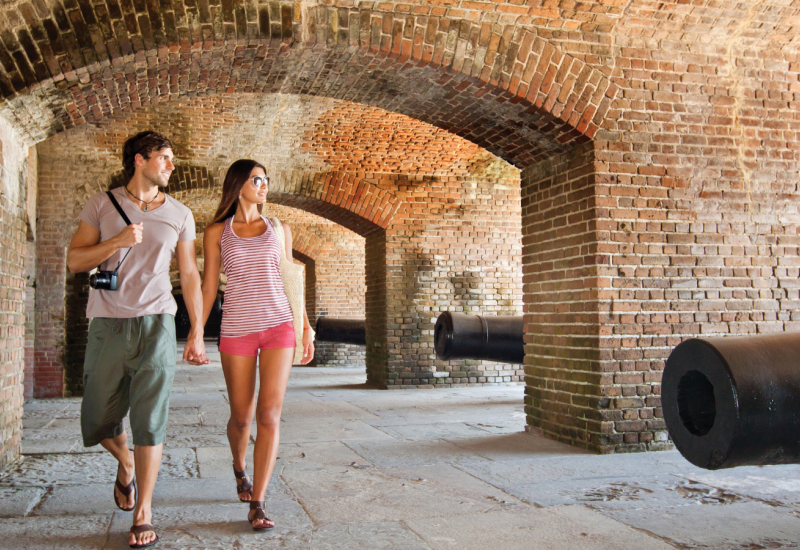Freshwater Florida
|

|
| At Ginnie Springs two divers explore the main cavern entrance and the limestone room beyond.|
Exploring the open-water basin of a north Florida spring is like no other experience in diving. Dive down and turn in any direction: it's like being in a light-filled orb of glass quivering on the tip of a glass maker's blowpipe. They're that clear.
Linked together by a netherworld of flooded caves, there are hundreds of springs flowing from the forest floor of north Florida. Here are six anyone with a C-card can dive.
Ginnie Springs Resort
||
|---|
|

|
| All the springs at Ginnie run to the Santa Fe River.|
Location - High Springs, 15 minutes west of I-75, off County Rd. 340. Look for the signs.
Dimensions - Ginnie: A bowl-shaped depression 100 feet across and 15 feet deep is linked to the Santa Fe River by a 150-foot spring run. Three smaller springs, Devil's Eye, Devil's Ear and Little Devil, are also accessible and combine to create a second flow into the river.
Water Temp/Vis - 72F/200 feet.
Open-Water Potential - At the bottom of Ginnie's shallow, sunny basin, you enter a cavern--the cavern's upper room is illuminated by enough light to be considered safe for open-water divers. At the back of the upper room, divers pass through a large opening into the amphitheater-sized ballroom. A permanent guideline on the floor leads to the cave entrance, which is grated off. You can't enter, but you'll feel like a city kid who has just opened a fire hydrant--several million gallons of water push through here each day.
Open-water divers can also explore the basins of Devil's Eye, Devil's Ear and Little Devil, but a strict no-lights policy is enforced since they lead to cave systems. From the Ear, you can drift dive 1,000 feet down the Santa Fe River, and back up the Ginnie Springs run to the larger basin.
The Price - $24 first day, $20 second day, $18 for certified cave divers. There is a $7 admission fee for non-divers.
Facilities - Campsites are available and there is a full-service dive shop/training center on site.
Contact Info - Tel: (800) 874-8571 or (386) 454-7188. Web: www.ginniesprings.com.
 |
| Vines cascade down from the chamber's opening and sunlight plays on the water, creating a primitive atmosphere at Devil's Den. |
Blue Grotto:
||
|---|
|

|
| Visitors peer into the dazzling spring at Blue Grotto, while divers prepare to exit the water.|
Location - Two miles northwest of Williston, off U.S. Alt.-27 North.
Dimensions - Entrance to the cavern is 30 feet high by 80 feet across, then gapes open to 40 feet by 150 feet.
Water Temp/Vis - 72F/200 feet.
Open-Water Potential - Guidelines take you down one side of the cavern, to about 100 feet, then up the other side. This basin is strictly for divers--no swimmers are permitted.
The Price - $27 for all-day diving.
Contact Info - Tel: (352) 528-5770. Fax: (352) 528-5704. Web: www.divebluegrotto.com.
Vortex Spring:
||
|---|
|

|
| The cave entrance at Ginnie's main spring is grated off, making it a good place to hang on--millions of gallons of water push through here every day.|
Location - North of Ponce De Leon, exit 15 off I-10.
Dimensions - The basin is 250 feet across and 50 feet deep. The cavern opening is 48 feet high and the cavern chamber is 70 feet across and 68 feet deep.
Water Temp/Vis - 68F/200 feet.
Open-Water Potential - You have access to the basin (until 11 p.m.) and two artificial caverns that are 55 feet in length. Both ends are open, making the passages safe for open-water divers. A buoyed line leads from the center of the basin down to the natural cavern entrance at 60 feet--the limit of safe penetration for open-water divers. Certified cavern divers are permitted to penetrate 65 feet into the passageway that leads to the cave, but should turn around when surface light is no longer visible.
This is one of the fishiest spring basins in the Sunshine State. "We've got koi carp that approach the length of your arm," says manager Connie Taylor. You are also guaranteed to have an encounter with American eels. Carry some beef jerky or a Slim-Jim--these diver-friendly creatures love a handout.
The Price - $25 for all-day diving (including night diving); $4 general admission for non-divers.
Facilities - Lodging facilities, campsites and dive shop on site.
Contact Info - Tel: (800) 342-0640 or (850) 836-4979. Fax: (850) 836-4557. Web: www.vortexspring.com.
 |
Devil's Den
Location - Northwest of Williston, off U.S. Alt. 27 North.
Dimensions - The open-water basin is 100 feet across and mushrooms out to 200 feet across at depth; depth fluctuates from 50 to 65 feet.
Water Temp/Vis - 72F/100 feet.
Open-Water Potential - Only divers and snorkelers are permitted in the underground spring (non-divers can dip into the heated pool or the two-and-a-half-acre manmade pond). Thousands of years ago, the cave's roof collapsed and opened up a "karst window." Steps lead down from the window to the basin, 60 feet below. The pyramidal rocky remains from the roof's collapse are under the platform, a debris cone that divers can circle.
The cave system in the deeper area of the basin has been barred off for the protection of open-water divers, but there are several swim-through tunnels with ambient light."If you can't see ambient light ahead of you as well as behind you, then you have to have cavern or cave certification to enter these areas," says Ginnie McKnight, manager of Devil's Den. As in most Florida springs, Grim Reaper signs greet you at the entrance to restricted areas as an extra reminder.
This spring is Southern Gothic: Devil's Den has a steamy, primitive atmosphere. Sunlight dapples the underground chamber and surface of the pool 60 feet below. Antediluvian vines cascade from the chamber's circular opening and the canopy of live oaks with shawls of Spanish moss is reflected in the water. The spring's vis is the clarity of melted ice cubes, making it easy for the careful observer to spot fossils from the Pleistocene Age.
The Price - $27 for all-day diving; $9 general admission for non-divers.
Facilities - You can spend the day or the week in the resort's cabins, RV park and primitive campgrounds. The dive shop on premises is a full-service training facility, including cavern and cave certifications.
Contact Info - Tel: (352) 528-3344. Fax: (352) 528-2400. Web: www.devilsden.com.
Madison Blue Spring:
||
|---|
|

|
| Divers return to the training platform at Madison Blue Spring.|
Location - Outside Madison on State Road 6, off the Withlacoochee River.
Dimensions - Basin is 80 feet by 100 feet to a depth of 30 feet.
Water Temp/Vis - 71F/200 feet.
Open-Water Potential - From the spring basin, you can see the waterfall in the spring run. Madison has a huge aperture that slopes down to a large cavern, where divers can feel the full force of the 120 million gallons of water that flows from the aquifer each day. Open-water divers should not venture past the cavern entrance and the no-lights rule is strictly enforced. Read the fine print on the waiver--if you're caught with a light, you'll never dive here again.
The Price - $15 per diver, $3 non-divers and $2 children. Diving and camping is $20.
Facilities - Bunkhouse accommodations are available. The dive shop on site is a full-service training facility.
Contact Info - Tel: (850) 971-2880. E-mail: [email protected]. Call ahead to make sure the spring is open-- the spring is sometimes flooded with dark water from the Withlacoochee River.
Weeki Wachee Springs Waterpark
Location - 45 minutes north of Tampa on U.S. 19.
Dimensions - 150 feet by 400 feet.
Water Temp/Vis - 74F/200 feet.
Open-Water Potential - Pre-dive briefings are given to familiarize divers with both the spring and the park. Non-diving companions can watch you dive from the 400-seat Mermaid Theater, and see the local fish--freshwater flounder, bream, pacus (an African herbivore that has been released in the Weeki Wachee River) and mullet--through 16 giant viewing windows. A maximum of 30 divers are kept to a maximum depth of 45 feet.
The Price - $39.95 for a full day--three dives and access to waterpark facilities and mermaid shows.
Contact Info - Neptune Divers of Weeki Wachee, Inc. Tel: (352) 597-4300. Web: www.WeekiWachee.com or www.NeptuneDivers.com.
Where the Springs Come From
Millions of years ago, Florida springs country looked a lot more familiar to divers than it does today. What is now a dark world of underground caves was once a vast, shallow plateau in a tropical sea.
The Floridan Plateau, remnants of an ancient mountain range, once lay between the deep waters of the Gulf of Mexico and the Atlantic Ocean, and was home to a wealth of marine life. On the reefs, corals and shellfish died and left behind their protective shells, which accumulated over time into a limestone base. After millions of years, geological forces pushed the plateau above the water again, where it became the peninsula of Florida. Rain water combined with decaying vegetation to form an acidic stew that seeped into the ground, slowly dissolving tunnels and caverns in the soft limestone.
This honeycombed bedrock became a vast reservoir, or aquifer, storing huge amounts of fresh water. Rainfall constantly resupplies the aquifer, and the overflow rises to the surface from the openings we know as springs, sinkholes and caves. In all, Florida's 300 springs pump more than seven billion gallons of water every day. Not bad for an old reef.
It's An Eel's Life
You may have journeyed a ways to get to Florida springs country, but probably not as far as the freshwater American eel has from its birthplace in the Sargasso Sea, south of Bermuda. If you happen to spot one of these wriggling members of the Anguillidae family drifting in a spring run, ponder how it got there:
American freshwater eels (Anguilla rostrata) are born in the ocean in late winter. Adult males and females swim from the Atlantic Coast to an area in the Sargasso Sea, where the females spawn. After mating, both the males and females die. Several days later, glasslike baby eels, called leptocephalus larvae, hatch. Each larva carries a tiny drop of oil, which allows it to float upward. Ribbons of larvae drift with the ocean currents, feeding on the microscopic life at the ocean's surface. A year after being hatched, the growing eels are about 3 inches long and have reached the eastern Atlantic or Gulf coasts.
During the spring, millions of female eels swim into the rivers of eastern North America, including the spring-fed rivers of Florida. The males stay in salty tidewaters, awaiting the return of the females in autumn, when they begin their migration back to the Sargasso Sea.
 |
Manatees of Crystal River
Thanks to the consistent warmth (72F) of its spring-fed waters, the King's Bay area of Crystal River is an important manatee habitat. Despite their enormous size and girth (the average adult is 10 feet long and weighs 1,000 pounds), manatees have very little body fat, and are dependent on the river's warmth to survive the winter.
Seven manatee sanctuaries and one national wildlife refuge ensure the creatures can live unmolested by man and encroaching development--and provide you with the opportunity to come face to droopy face with these docile creatures.
The best time to find manatees is from November through April when they leave the Gulf of Mexico and enter King's Bay in search of warmer waters. And the best time of day to swim with them is in the morning, so plan on staying in the area the night before. Coming here Monday through Friday also dramatically increases your odds, as the rivers are far less crowded during the week.
For more details, contact these operators serving the Crystal River area: American Pro Dive Center (800-291-DIVE or 352-563-0041, www.americanprodive.com), Crystal Lodge Dive Center (352-795-6798, www.manatee-central.com), and Port Paradise Resort (352-795-7234 or 800-443-0875 in Fla.).
****Meeting Manatees: The Rules of Engagement**
Know the law -** It's illegal to harass, hunt, capture or kill any marine mammal, punishable by federal fines of up to $100,000 and/or one year in prison.
**
Location is everything -** Never enter a designated manatee sanctuary.
**
Look, but don't touch -** This is debatable, but many people say that you shouldn't touch the manatees. It'll be tempting, especially when they approach you and appear to want to be petted. Obviously, never grab, ride or chase a manatee.
**
Snorkel preferred -** Snorkeling is the preferred method of approaching manatees. The sound and bubbles of scuba frighten them away. **
Food for thought -** Do not feed manatees or attempt to give them water.
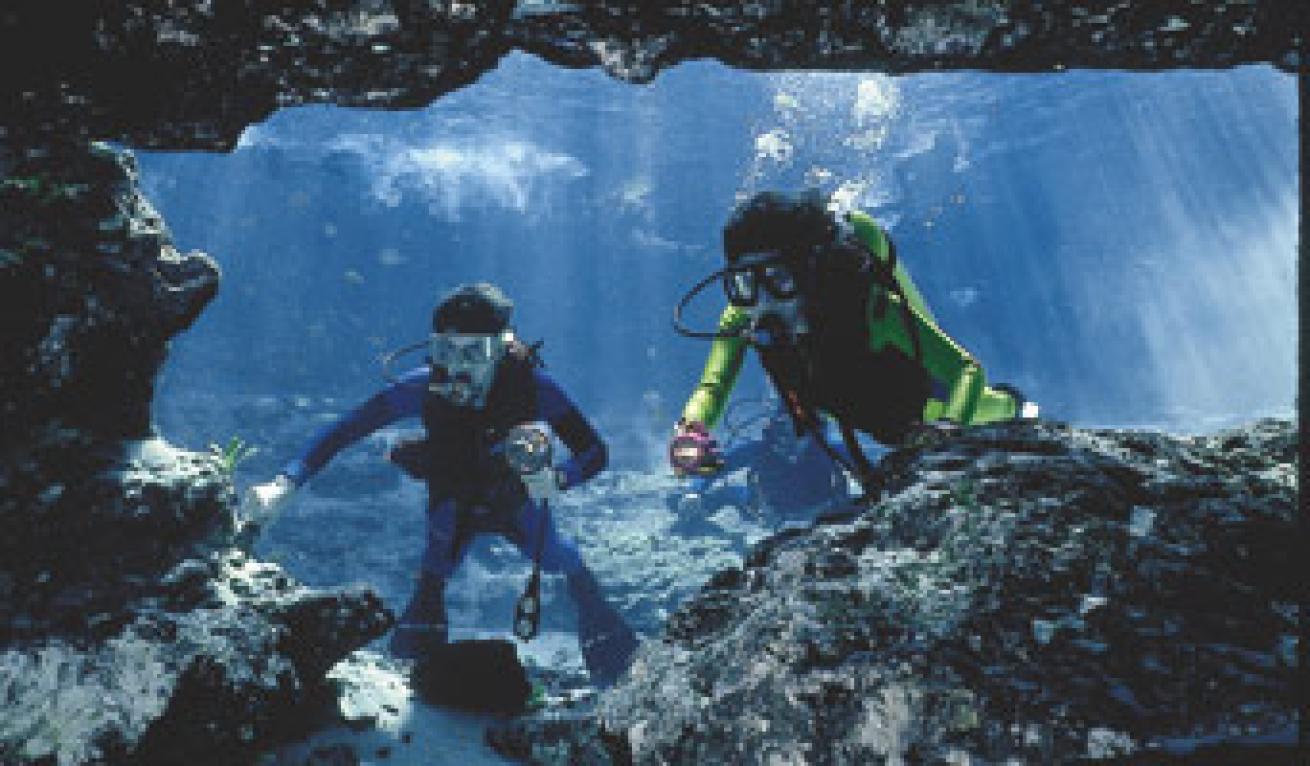
At Ginnie Springs two divers explore the main cavern entrance and the limestone room beyond.
Exploring the open-water basin of a north Florida spring is like no other experience in diving. Dive down and turn in any direction: it's like being in a light-filled orb of glass quivering on the tip of a glass maker's blowpipe. They're that clear.
Linked together by a netherworld of flooded caves, there are hundreds of springs flowing from the forest floor of north Florida. Here are six anyone with a C-card can dive.
Ginnie Springs Resort
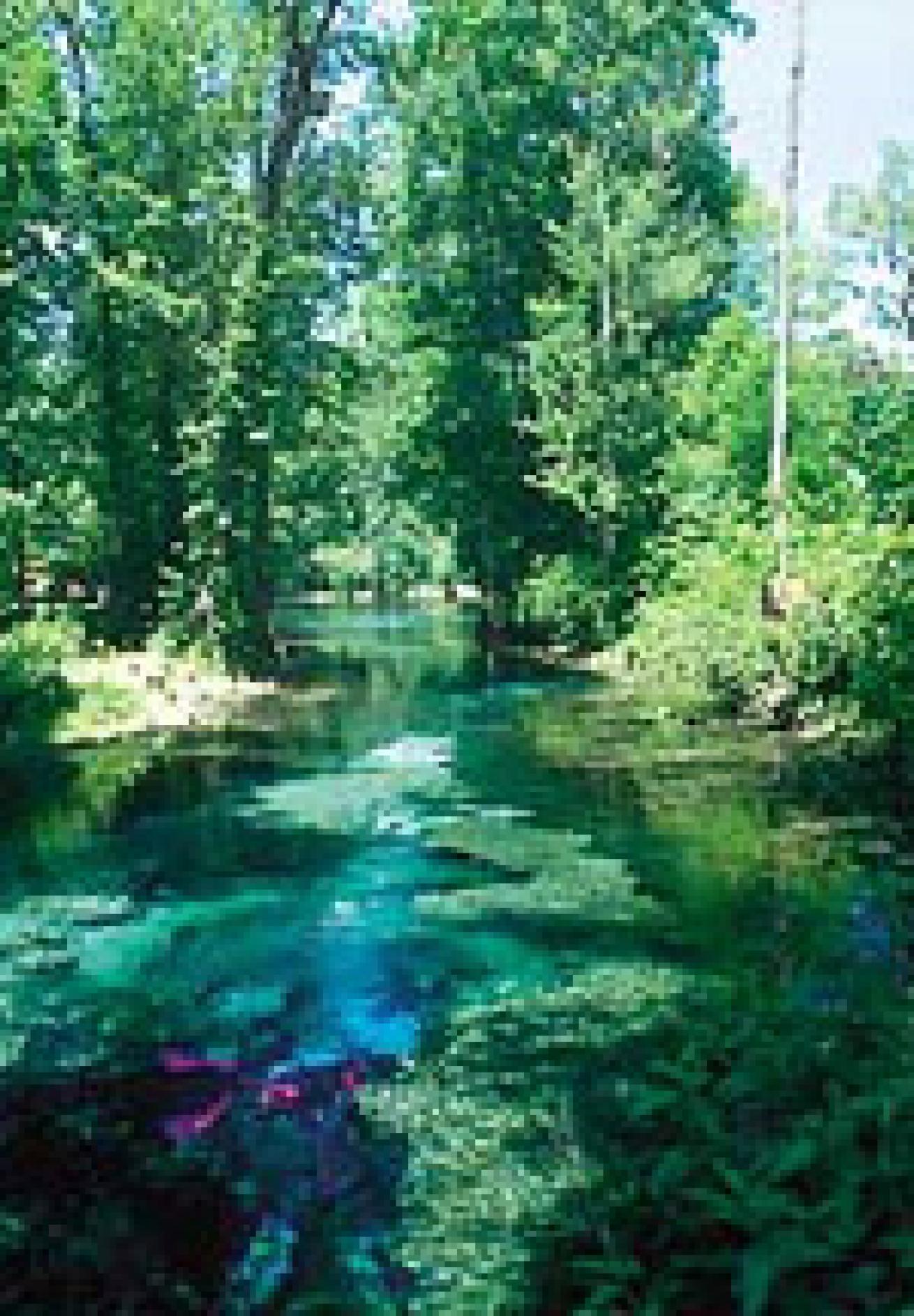
All the springs at Ginnie run to the Santa Fe River.
Dimensions - Ginnie: A bowl-shaped depression 100 feet across and 15 feet deep is linked to the Santa Fe River by a 150-foot spring run. Three smaller springs, Devil's Eye, Devil's Ear and Little Devil, are also accessible and combine to create a second flow into the river.
Water Temp/Vis - 72F/200 feet.
Open-Water Potential - At the bottom of Ginnie's shallow, sunny basin, you enter a cavern--the cavern's upper room is illuminated by enough light to be considered safe for open-water divers. At the back of the upper room, divers pass through a large opening into the amphitheater-sized ballroom. A permanent guideline on the floor leads to the cave entrance, which is grated off. You can't enter, but you'll feel like a city kid who has just opened a fire hydrant--several million gallons of water push through here each day.
Open-water divers can also explore the basins of Devil's Eye, Devil's Ear and Little Devil, but a strict no-lights policy is enforced since they lead to cave systems. From the Ear, you can drift dive 1,000 feet down the Santa Fe River, and back up the Ginnie Springs run to the larger basin.
The Price - $24 first day, $20 second day, $18 for certified cave divers. There is a $7 admission fee for non-divers.
Facilities - Campsites are available and there is a full-service dive shop/training center on site.
Contact Info - Tel: (800) 874-8571 or (386) 454-7188. Web: www.ginniesprings.com.
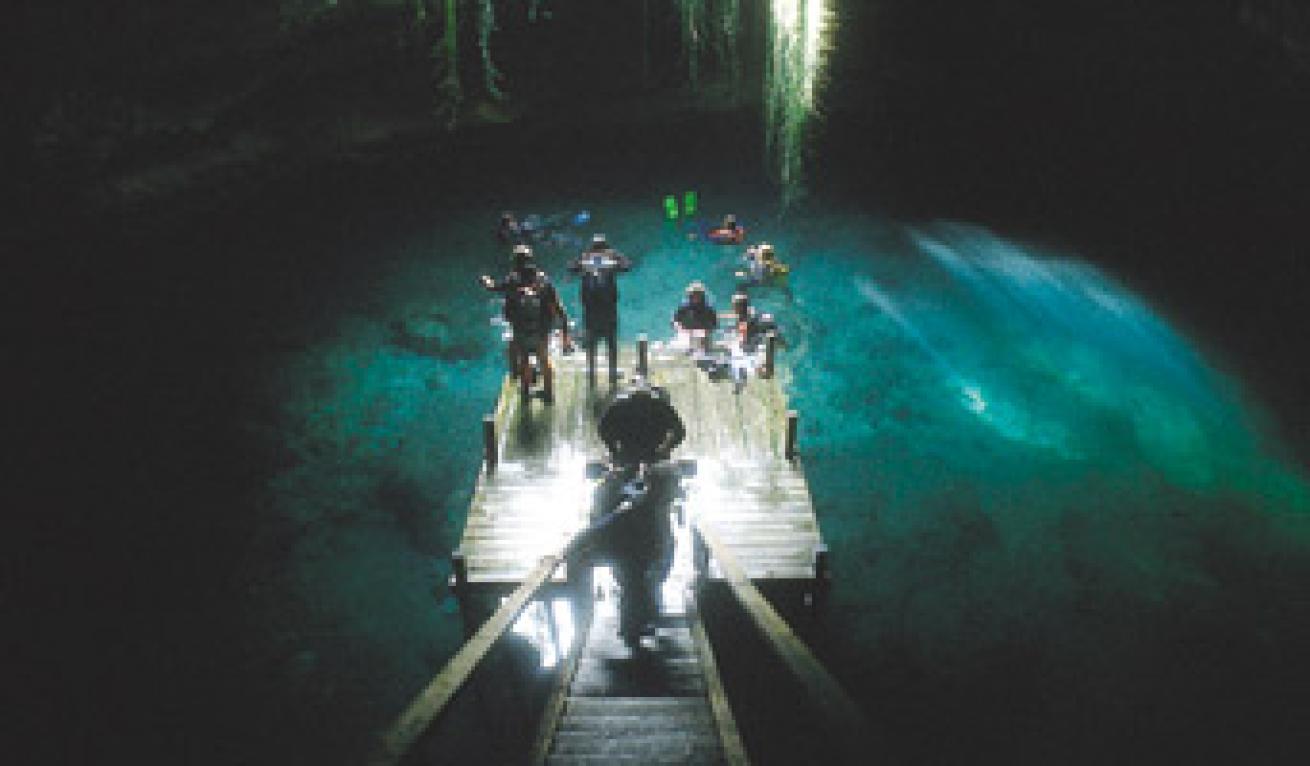
Vines cascade down from the chamber's opening and sunlight plays on the water, creating a primitive atmosphere at Devil's Den.
Blue Grotto:
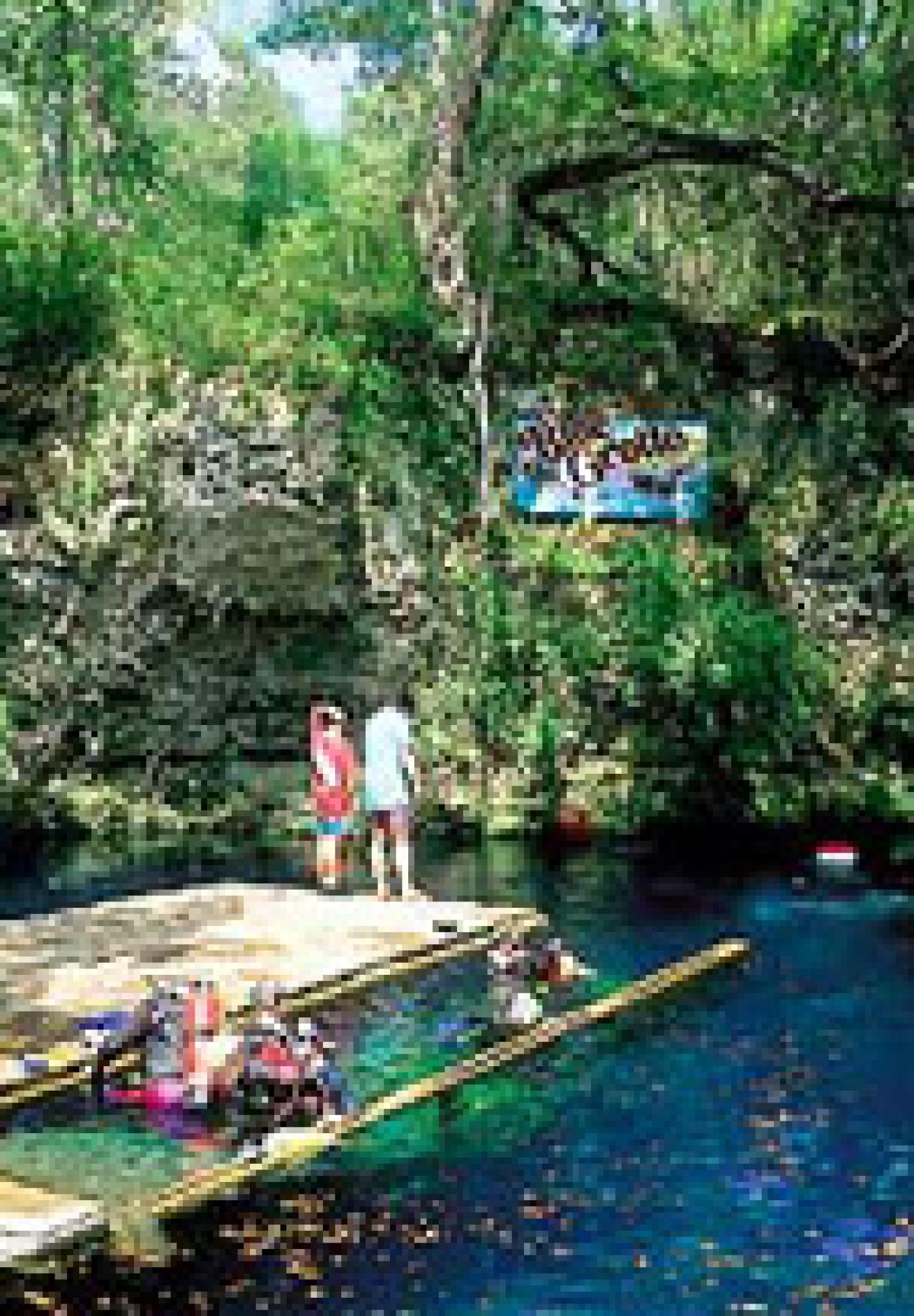
Visitors peer into the dazzling spring at Blue Grotto, while divers prepare to exit the water.|
Dimensions - Entrance to the cavern is 30 feet high by 80 feet across, then gapes open to 40 feet by 150 feet.
Water Temp/Vis - 72F/200 feet.
Open-Water Potential - Guidelines take you down one side of the cavern, to about 100 feet, then up the other side. This basin is strictly for divers--no swimmers are permitted.
The Price - $27 for all-day diving.
Contact Info - Tel: (352) 528-5770. Fax: (352) 528-5704. Web: www.divebluegrotto.com.
Vortex Spring:
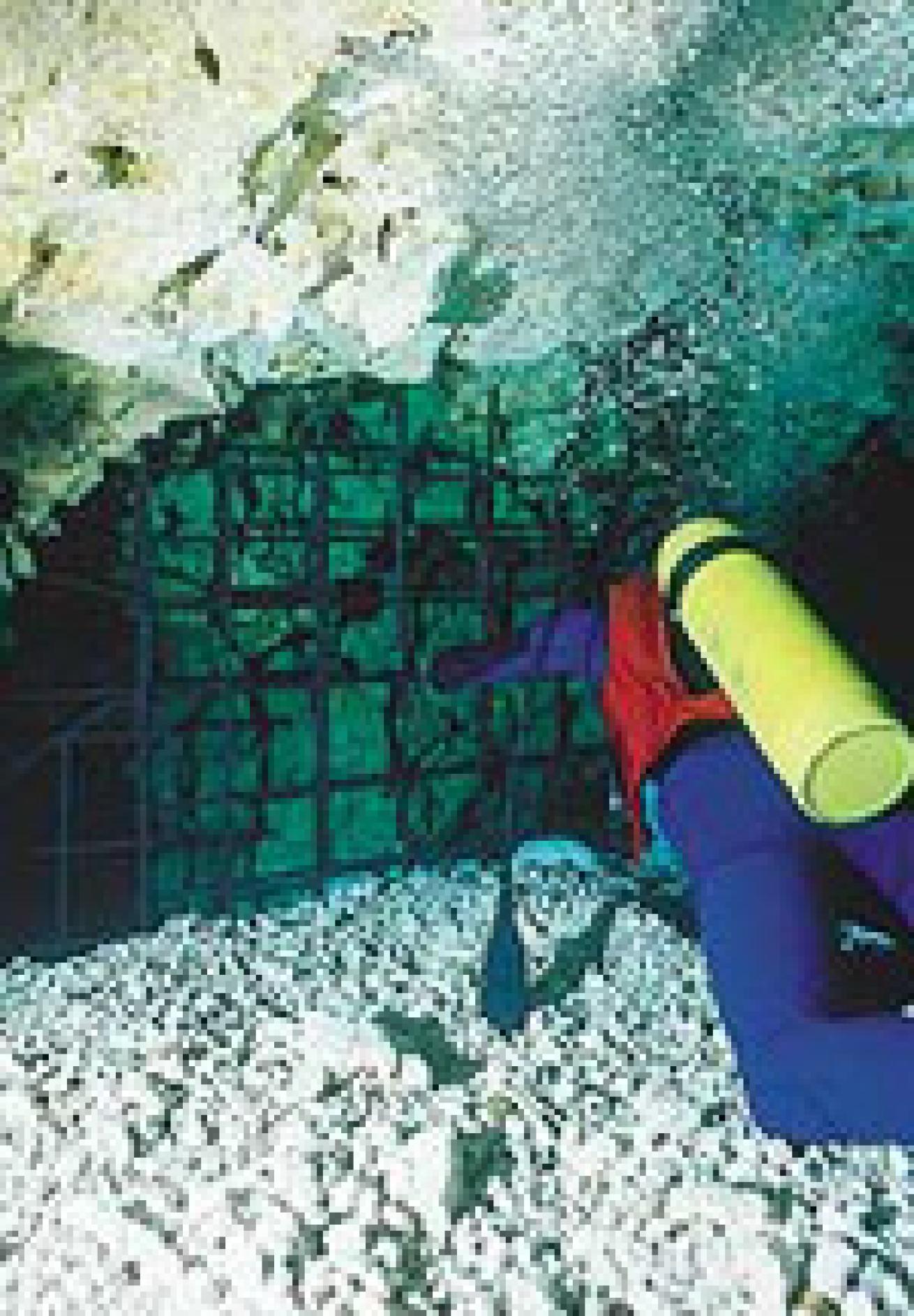
The cave entrance at Ginnie's main spring is grated off, making it a good place to hang on--millions of gallons of water push through here every day.
Dimensions - The basin is 250 feet across and 50 feet deep. The cavern opening is 48 feet high and the cavern chamber is 70 feet across and 68 feet deep.
Water Temp/Vis - 68F/200 feet.
Open-Water Potential - You have access to the basin (until 11 p.m.) and two artificial caverns that are 55 feet in length. Both ends are open, making the passages safe for open-water divers. A buoyed line leads from the center of the basin down to the natural cavern entrance at 60 feet--the limit of safe penetration for open-water divers. Certified cavern divers are permitted to penetrate 65 feet into the passageway that leads to the cave, but should turn around when surface light is no longer visible.
This is one of the fishiest spring basins in the Sunshine State. "We've got koi carp that approach the length of your arm," says manager Connie Taylor. You are also guaranteed to have an encounter with American eels. Carry some beef jerky or a Slim-Jim--these diver-friendly creatures love a handout.
The Price - $25 for all-day diving (including night diving); $4 general admission for non-divers.
Facilities - Lodging facilities, campsites and dive shop on site.
Contact Info - Tel: (800) 342-0640 or (850) 836-4979. Fax: (850) 836-4557. Web: www.vortexspring.com.
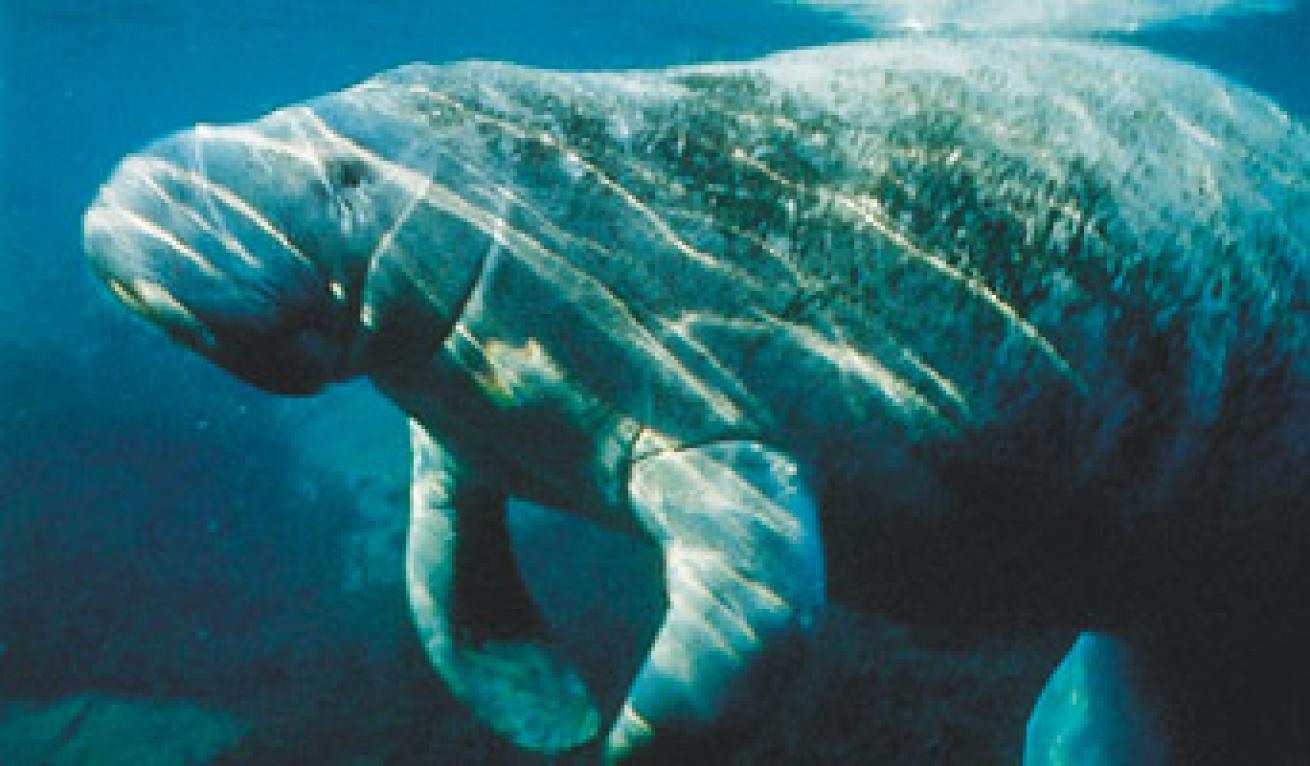
Devil's Den
Location - Northwest of Williston, off U.S. Alt. 27 North.
Dimensions - The open-water basin is 100 feet across and mushrooms out to 200 feet across at depth; depth fluctuates from 50 to 65 feet.
Water Temp/Vis - 72F/100 feet.
Open-Water Potential - Only divers and snorkelers are permitted in the underground spring (non-divers can dip into the heated pool or the two-and-a-half-acre manmade pond). Thousands of years ago, the cave's roof collapsed and opened up a "karst window." Steps lead down from the window to the basin, 60 feet below. The pyramidal rocky remains from the roof's collapse are under the platform, a debris cone that divers can circle.
The cave system in the deeper area of the basin has been barred off for the protection of open-water divers, but there are several swim-through tunnels with ambient light."If you can't see ambient light ahead of you as well as behind you, then you have to have cavern or cave certification to enter these areas," says Ginnie McKnight, manager of Devil's Den. As in most Florida springs, Grim Reaper signs greet you at the entrance to restricted areas as an extra reminder.
This spring is Southern Gothic: Devil's Den has a steamy, primitive atmosphere. Sunlight dapples the underground chamber and surface of the pool 60 feet below. Antediluvian vines cascade from the chamber's circular opening and the canopy of live oaks with shawls of Spanish moss is reflected in the water. The spring's vis is the clarity of melted ice cubes, making it easy for the careful observer to spot fossils from the Pleistocene Age.
The Price - $27 for all-day diving; $9 general admission for non-divers.
Facilities - You can spend the day or the week in the resort's cabins, RV park and primitive campgrounds. The dive shop on premises is a full-service training facility, including cavern and cave certifications.
Contact Info - Tel: (352) 528-3344. Fax: (352) 528-2400. Web: www.devilsden.com.
Madison Blue Spring:

Divers return to the training platform at Madison Blue Spring.|
Dimensions - Basin is 80 feet by 100 feet to a depth of 30 feet.
Water Temp/Vis - 71F/200 feet.
Open-Water Potential - From the spring basin, you can see the waterfall in the spring run. Madison has a huge aperture that slopes down to a large cavern, where divers can feel the full force of the 120 million gallons of water that flows from the aquifer each day. Open-water divers should not venture past the cavern entrance and the no-lights rule is strictly enforced. Read the fine print on the waiver--if you're caught with a light, you'll never dive here again.
The Price - $15 per diver, $3 non-divers and $2 children. Diving and camping is $20.
Facilities - Bunkhouse accommodations are available. The dive shop on site is a full-service training facility.
Contact Info - Tel: (850) 971-2880. E-mail: [email protected]. Call ahead to make sure the spring is open-- the spring is sometimes flooded with dark water from the Withlacoochee River.
Weeki Wachee Springs Waterpark
Location - 45 minutes north of Tampa on U.S. 19.
Dimensions - 150 feet by 400 feet.
Water Temp/Vis - 74F/200 feet.
Open-Water Potential - Pre-dive briefings are given to familiarize divers with both the spring and the park. Non-diving companions can watch you dive from the 400-seat Mermaid Theater, and see the local fish--freshwater flounder, bream, pacus (an African herbivore that has been released in the Weeki Wachee River) and mullet--through 16 giant viewing windows. A maximum of 30 divers are kept to a maximum depth of 45 feet.
The Price - $39.95 for a full day--three dives and access to waterpark facilities and mermaid shows.
Contact Info - Neptune Divers of Weeki Wachee, Inc. Tel: (352) 597-4300. Web: www.WeekiWachee.com or www.NeptuneDivers.com.
Where the Springs Come From
Millions of years ago, Florida springs country looked a lot more familiar to divers than it does today. What is now a dark world of underground caves was once a vast, shallow plateau in a tropical sea.
The Floridan Plateau, remnants of an ancient mountain range, once lay between the deep waters of the Gulf of Mexico and the Atlantic Ocean, and was home to a wealth of marine life. On the reefs, corals and shellfish died and left behind their protective shells, which accumulated over time into a limestone base. After millions of years, geological forces pushed the plateau above the water again, where it became the peninsula of Florida. Rain water combined with decaying vegetation to form an acidic stew that seeped into the ground, slowly dissolving tunnels and caverns in the soft limestone.
This honeycombed bedrock became a vast reservoir, or aquifer, storing huge amounts of fresh water. Rainfall constantly resupplies the aquifer, and the overflow rises to the surface from the openings we know as springs, sinkholes and caves. In all, Florida's 300 springs pump more than seven billion gallons of water every day. Not bad for an old reef.
It's An Eel's Life
You may have journeyed a ways to get to Florida springs country, but probably not as far as the freshwater American eel has from its birthplace in the Sargasso Sea, south of Bermuda. If you happen to spot one of these wriggling members of the Anguillidae family drifting in a spring run, ponder how it got there:
American freshwater eels (Anguilla rostrata) are born in the ocean in late winter. Adult males and females swim from the Atlantic Coast to an area in the Sargasso Sea, where the females spawn. After mating, both the males and females die. Several days later, glasslike baby eels, called leptocephalus larvae, hatch. Each larva carries a tiny drop of oil, which allows it to float upward. Ribbons of larvae drift with the ocean currents, feeding on the microscopic life at the ocean's surface. A year after being hatched, the growing eels are about 3 inches long and have reached the eastern Atlantic or Gulf coasts.
During the spring, millions of female eels swim into the rivers of eastern North America, including the spring-fed rivers of Florida. The males stay in salty tidewaters, awaiting the return of the females in autumn, when they begin their migration back to the Sargasso Sea.
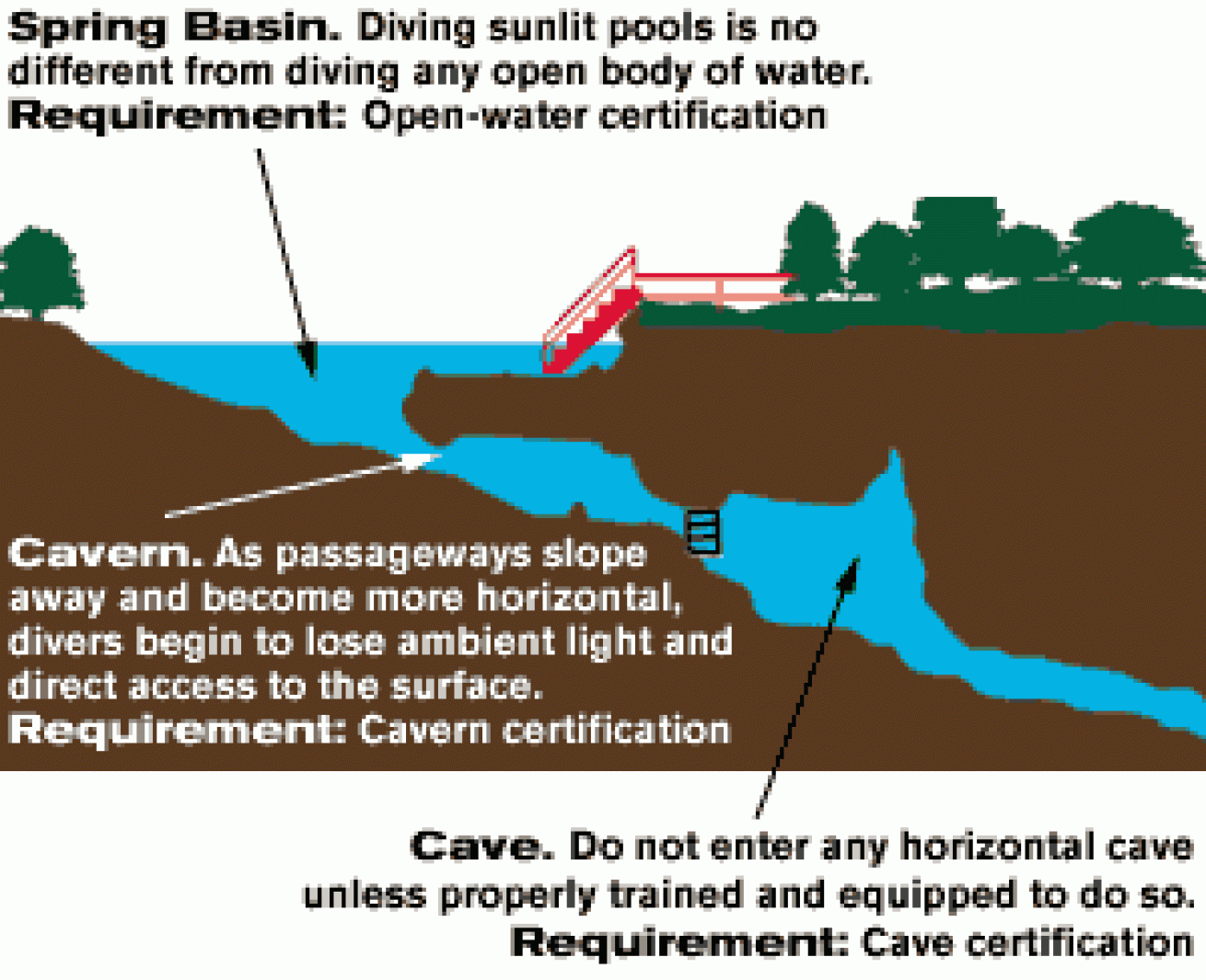
Manatees of Crystal River
Thanks to the consistent warmth (72F) of its spring-fed waters, the King's Bay area of Crystal River is an important manatee habitat. Despite their enormous size and girth (the average adult is 10 feet long and weighs 1,000 pounds), manatees have very little body fat, and are dependent on the river's warmth to survive the winter.
Seven manatee sanctuaries and one national wildlife refuge ensure the creatures can live unmolested by man and encroaching development--and provide you with the opportunity to come face to droopy face with these docile creatures.
The best time to find manatees is from November through April when they leave the Gulf of Mexico and enter King's Bay in search of warmer waters. And the best time of day to swim with them is in the morning, so plan on staying in the area the night before. Coming here Monday through Friday also dramatically increases your odds, as the rivers are far less crowded during the week.
For more details, contact these operators serving the Crystal River area: American Pro Dive Center (800-291-DIVE or 352-563-0041, www.americanprodive.com), Crystal Lodge Dive Center (352-795-6798, www.manatee-central.com), and Port Paradise Resort (352-795-7234 or 800-443-0875 in Fla.).
****Meeting Manatees: The Rules of Engagement**
Know the law -** It's illegal to harass, hunt, capture or kill any marine mammal, punishable by federal fines of up to $100,000 and/or one year in prison.
**
Location is everything -** Never enter a designated manatee sanctuary.
**
Look, but don't touch -** This is debatable, but many people say that you shouldn't touch the manatees. It'll be tempting, especially when they approach you and appear to want to be petted. Obviously, never grab, ride or chase a manatee.
**
Snorkel preferred -** Snorkeling is the preferred method of approaching manatees. The sound and bubbles of scuba frighten them away. **
Food for thought -** Do not feed manatees or attempt to give them water.



